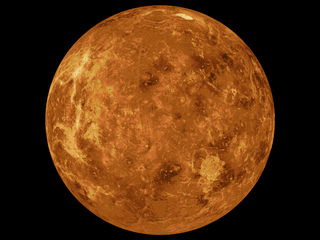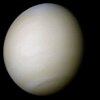
The Pioneer Venus project was part of the Pioneer program consisting of two spacecraft, the Pioneer Venus Orbiter and the Pioneer Venus Multiprobe, launched to Venus in 1978. The program was managed by NASA's Ames Research Center. An official Ames documentary film titled "Venus Pioneers" is visible on George Van Valkenburg's YouTube Channel.
A gender symbol is a pictogram or glyph used to represent either biological sex or sociological gender in either biology, medicine, genealogy or selective breeding, or in sociology, gender politics, LGBT subculture and identity politics.

Maat Mons is a massive shield volcano. It is the second-highest mountain, and the highest volcano, on the planet Venus. It rises 8 kilometres (5.0 mi) above the mean planetary radius at 0.5°N 194.6°E, and nearly 5 km above the surrounding plains. It is named after the Egyptian goddess of truth and justice, Ma'at.

Venus is a planet with striking geology. Of all the other planets in the Solar System, it is the one nearest to Earth and most like it in terms of mass, but has no magnetic field or recognizable plate tectonic system. Much of the ground surface is exposed volcanic bedrock, some with thin and patchy layers of soil covering, in marked contrast with Earth, the Moon, and Mars. Some impact craters are present, but Venus is similar to Earth in that there are much fewer craters than on the other rocky planets that are largely covered by them.

Snegurochka (diminutive) or Snegurka, or The Snow Maiden, is a character in Russian fairy tales.

The colonization of Venus has been a subject of many works of science fiction since before the dawn of spaceflight, and is still discussed from both a fictional and a scientific standpoint. However, with the discovery of Venus's extremely hostile surface environment, attention has largely shifted towards the colonization of the Moon and Mars instead, with proposals for Venus focused on colonies floating in the upper-middle atmosphere and on terraforming.

The terraforming of Venus is the hypothetical process of engineering the global environment of the planet Venus in such a way as to make it suitable for human habitation. Terraforming Venus was first scholarly proposed by the astronomer Carl Sagan in 1961, although fictional treatments, such as The Big Rain of The Psychotechnic League by novelist Poul Anderson, preceded it. Adjustments to the existing environment of Venus to support human life would require at least three major changes to the planet's atmosphere:
- Reducing Venus' surface temperature of 462 °C
- eliminating most of the planet's dense 9.2 MPa (91 atm) carbon dioxide and sulfur dioxide atmosphere via removal or conversion to some other form
- the addition of breathable oxygen to the atmosphere.
The Daughter of the Snows is a fantastic ballet in three acts and five scenes, with choreography by Marius Petipa and music by Ludwig Minkus. The libretto by Marius Petipa is based on the play The Snow Maiden by Alexander Ostrovsky, inspired by a Russian folk fairy tale about Snegurochka from the folklore collection by Alexander Afanasyev.

A pancake dome, also known as a lava dome, is an unusual type of volcano found on the planet Venus. They are widely scattered on that planet and often form groups or clusters, though with smaller numbers of pancake domes in each group than is typical for the more common shield volcanos. They are commonly found near coronae and tesserae in the lowland plains. Pancake domes are between 10 and 100 times larger than volcanic domes formed on Earth.
Theia Mons is a large shield volcano on Venus. Its name is derived from the titan of Greek mythology.

The Snow Maiden is a 1952 Soviet/Russian traditionally animated feature film. It was produced at the Soyuzmultfilm studio in Moscow and is based on the Slavic-pagan play of the same name by Aleksandr Ostrovsky. Music from Nikolai Rimsky-Korsakov's opera The Snow Maiden is used, arranged for the film by L. Shvarts. The animated film was shown at movie theater.

The surface of Venus is dominated by volcanic features and has more volcanoes than any other planet in the Solar System. It has a surface that is 90% basalt, and about 65% of the planet consists of a mosaic of volcanic lava plains, indicating that volcanism played a major role in shaping its surface. There are more than 1,000 volcanic structures and possible periodic resurfacing of Venus by floods of lava. The planet may have had a major global resurfacing event about 500 million years ago, from what scientists can tell from the density of impact craters on the surface. Venus has an atmosphere rich in carbon dioxide, with a density that is 90 times greater than Earth's atmosphere.

Guinevere Planitia is an expansive lowland region of Venus that lies east of Beta Regio and west of Eistla Regio. These low-lying plains, particularly in the western portion, are characterized by apparent volcanic source vents and broad regions of bright, dark, and mottled deposits. They are the only break in an equatorially connected zone of highlands and tectonic zones. The types, numbers, and patterns of mapped tectonic features and small volcanic landforms in the region provide important detail in the interpretation and evolution of venusian landscape.

Irnini Mons is a volcanic structure on the planet Venus, and is named after the Assyro-Babylonian goddess of cedar-tree mountains. It has a diameter of 475 km (295 mi), a height of 1.75 km (1.09 mi), and is located in Venus' northern hemisphere. More specifically, it is located in the central Eistla Regio region at in the V-20 quadrangle. Sappho Patera, a 225 km (140 mi) diameter wide, caldera-like, depression tops the summit of Irnini Mons. The primary structural features surrounding Irnini Mons are graben, seen as linear depressed sections of rock, radiating from the central magma chamber. Also, concentric, circular ridges and graben outline the Sappho Patera depression at the summit. The volcano is crossed by various rift zones, including the north-south trending Badb Linea rift, the Guor Linea rift extending to the northwest, and the Virtus Linea rift continuing to the southeast.
Snegurochka or Snow Maiden, is a character in Russian fairy tales.

The surface of Venus is dominated by geologic features that include volcanoes, large impact craters, and aeolian erosion and sedimentation landforms. Venus has a topography reflecting its single, strong crustal plate, with a unimodal elevation distribution that preserves geologic structures for long periods of time. Studies of the Venusian surface are based on imaging, radar, and altimetry data collected from several exploratory space probes, particularly Magellan, since 1961. Despite its similarities to Earth in size, mass, density, and possibly composition, Venus has a unique geology that is unlike Earth's. Although much older than Earth's, the surface of Venus is relatively young compared to other terrestrial planets, possibly due to a global-scale resurfacing event that buried much of the previous rock record. Venus is believed to have approximately the same bulk elemental composition as Earth, due to the physical similarities, but the exact composition is unknown. The surface conditions on Venus are more extreme than on Earth, with temperatures ranging from 453 to 473 °C and pressures of 95 bar. Venus lacks water, which makes crustal rock stronger and helps preserve surface features. The features observed provide evidence for the geological processes at work. Twenty feature types have been categorized thus far. These classes include local features, such as craters, coronae, and undae, as well as regional-scale features, such as planitiae, plana, and tesserae.

The mapping of Venus refers to the process and results of human description of the geological features of the planet Venus. It involves surface radar images of Venus, construction of geological maps, and the identification of stratigraphic units, volumes of rock with a similar age.












